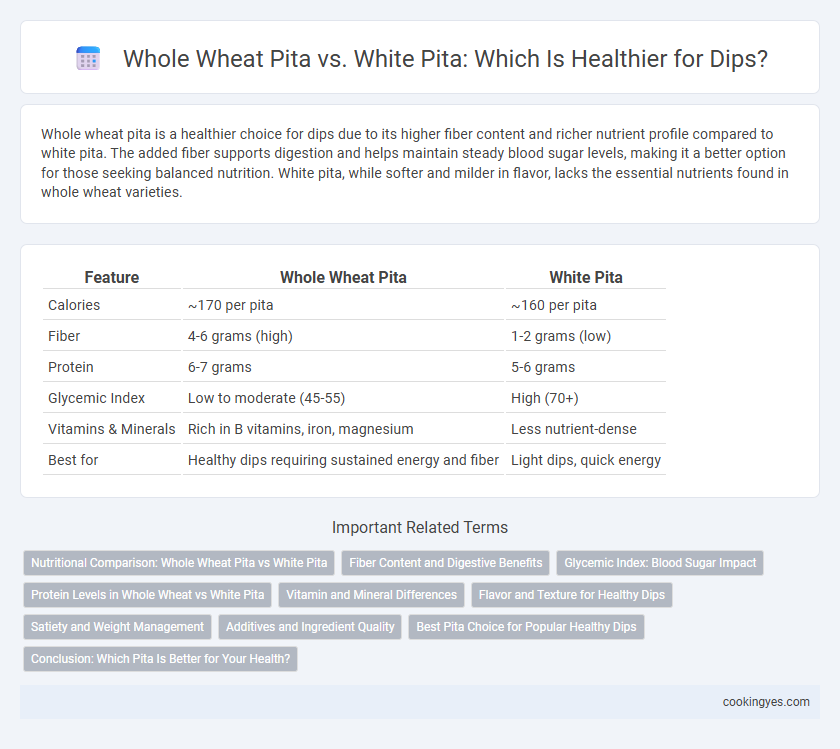Whole wheat pita is a healthier choice for dips due to its higher fiber content and richer nutrient profile compared to white pita. The added fiber supports digestion and helps maintain steady blood sugar levels, making it a better option for those seeking balanced nutrition. White pita, while softer and milder in flavor, lacks the essential nutrients found in whole wheat varieties.
Table of Comparison
| Feature | Whole Wheat Pita | White Pita |
|---|---|---|
| Calories | ~170 per pita | ~160 per pita |
| Fiber | 4-6 grams (high) | 1-2 grams (low) |
| Protein | 6-7 grams | 5-6 grams |
| Glycemic Index | Low to moderate (45-55) | High (70+) |
| Vitamins & Minerals | Rich in B vitamins, iron, magnesium | Less nutrient-dense |
| Best for | Healthy dips requiring sustained energy and fiber | Light dips, quick energy |
Nutritional Comparison: Whole Wheat Pita vs White Pita
Whole wheat pita contains higher fiber content, essential vitamins, and minerals like magnesium and iron, promoting better digestion and sustained energy levels compared to white pita. White pita is typically made from refined flour, which has lower fiber and fewer nutrients due to processing that removes bran and germ. Choosing whole wheat pita enhances nutritional benefits when paired with healthy dips, supporting balanced blood sugar and improved heart health.
Fiber Content and Digestive Benefits
Whole wheat pita contains significantly higher fiber content compared to white pita, promoting better digestive health and regular bowel movements. The increased fiber in whole wheat pita aids in maintaining blood sugar levels and supports gut microbiota balance. Choosing whole wheat pita for healthy dips enhances satiety and provides sustained energy release.
Glycemic Index: Blood Sugar Impact
Whole wheat pita has a lower glycemic index (GI) than white pita, causing a slower and more stable blood sugar response. This makes whole wheat pita a better choice for maintaining steady energy levels and reducing insulin spikes when paired with healthy dips like hummus or tzatziki. Choosing whole wheat pita supports improved glycemic control and overall metabolic health compared to white pita.
Protein Levels in Whole Wheat vs White Pita
Whole wheat pita contains higher protein levels than white pita, providing approximately 6 grams of protein per serving compared to 3-4 grams in white pita. This increased protein content supports muscle repair and helps maintain satiety when paired with healthy dips like hummus or tzatziki. Choosing whole wheat pita enhances nutritional value while complementing the protein-rich qualities of nutrient-dense dips.
Vitamin and Mineral Differences
Whole wheat pita contains higher levels of essential vitamins and minerals compared to white pita, including increased amounts of B vitamins such as niacin and folate, as well as important minerals like magnesium, zinc, and iron. The presence of the bran and germ in whole wheat pita enhances its nutrient density, making it a better choice for supporting energy metabolism and immune function when paired with healthy dips. White pita, processed and refined, offers fewer micronutrients but may provide a softer texture preferred for some dips.
Flavor and Texture for Healthy Dips
Whole wheat pita offers a richer, nuttier flavor and a denser, chewier texture that complements savory and creamy healthy dips like hummus and avocado spread. White pita provides a lighter, softer texture with a mild taste that allows the dip's flavors to stand out without overpowering them. Choosing whole wheat pita enhances the overall dipping experience with added fiber and nutrients, while white pita suits those preferring a subtler bread base for delicate dip flavors.
Satiety and Weight Management
Whole wheat pita offers higher fiber content compared to white pita, enhancing satiety and supporting weight management by reducing overall calorie intake. The complex carbohydrates in whole wheat pita promote steady blood sugar levels, helping to curb hunger and prevent overeating. Incorporating whole wheat pita as a base for healthy dips can contribute to a balanced diet and effective weight control.
Additives and Ingredient Quality
Whole wheat pita contains higher fiber content and fewer additives compared to white pita, making it a superior choice for healthy dips. The ingredient quality in whole wheat pita typically includes whole grain flour with minimal processing, reducing the presence of preservatives and artificial additives. White pita often contains refined flour and may include more additives to enhance texture and shelf life, which can impact nutritional value negatively.
Best Pita Choice for Popular Healthy Dips
Whole wheat pita offers higher fiber content and more nutrients compared to white pita, making it the best choice for healthy dips like hummus, tzatziki, and baba ganoush. The denser texture and nutty flavor of whole wheat pita complement the creamy consistency of these dips, enhancing both taste and nutritional benefits. In contrast, white pita, though softer and milder, lacks the essential whole grain nutrients vital for a balanced diet.
Conclusion: Which Pita Is Better for Your Health?
Whole wheat pita contains more fiber, vitamins, and minerals compared to white pita, supporting better digestion and sustained energy release. White pita has a softer texture but lacks the nutritional density found in whole wheat varieties, making it less ideal for health-conscious choices. For healthier dips, whole wheat pita is the better option to maximize nutrient intake and maintain balanced blood sugar levels.
Whole Wheat Pita vs White Pita for healthy dips Infographic

 cookingyes.com
cookingyes.com